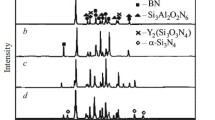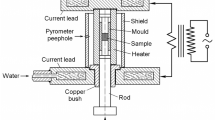Phase formation was regarded during the reactive sintering of boron carbide materials in the presence of silicon or aluminum, or silicon-aluminum melts. The inter-phase interaction was investigated, the melting (decomposition) temperatures as well as crystallographic data on the phases in the regarded systems were considered. Methods for reducing the content of Si and Al4C3 in the composition of the reactive-sintered material were discussed as these substances negatively affect the physical and chemical properties of the material.



Similar content being viewed by others
References
A. K. Suri, C. Subramanian, J. K. Sonber, et al., “Synthesis and consolidation of boron carbide: a review,” Int. Mater. Rev., 55(1), 4 – 40 (2010). https://doi.org/10.1179/095066009X12506721665211.
F. Thevenot, “Boron carbide — a comprehensive review,” J. Europ. Ceram. Soc., 6(4), 205 – 225 (1990). https://doi.org/10.1016/0955-2219(90)90048-K.
R. A. Andrievski, “Micro- and nanosized boron carbide: synthesis, structure and properties” [in Russian], Usp. Khim., 81(6), 549 – 559 (2012).
D. Sciti, L. Silvestroni, V. Medri, et al., “Sintering and densification mechanisms of ultra-high temperature ceramics,” Ultra-High Temperature Ceramics: Materials for Extreme Environment Applications (2014) p. 112 – 143. https://onlinelibrary.wiley.com/doi/10.1002/9781118700853.ch6/summary.
G. G. Gnesin, Carbide-Silicon Materials [in Russian], Metallurgiya, Moscow (1977) p. 373 – 376.
M. P. Dariel and N. Frage, “Reaction bonded boron carbide: recent developments,” Adv. Appl. Ceram., 111, No. 5/6, 301 – 310 (2012). https://doi.org/10.1179/1743676111Y.0000000078.
A. Thuault, S. Marinel, E. Savary, et al., “Processing of reaction-bonded B4C–SiC composites in a single-mode microwave cavity,” Ceram. Int., 39(2), 1215 – 1219 (2013). https://doi.org/10.1016/j.ceramint.2012.07.047.
Pat. US 7332221. M. K. Aghajanian, A. L. McCormick, B. N. Morgan, et al., “Boron carbide composite bodies, and methods for making same,” 2008. https://www.google.com/patents/US7332221.
US Pat. Appl. 13/752,135. F. E. Anderson, K. R. McNerney, and S. M. Brazil, “Boron-silicon-carbon ceramic materials and method of making,” 2013. https://www.google.com/patents/US20130168905.
Y. Zhou, D. Ni, Y. Kan, et al., “Microstructure and mechanical properties of reaction bonded B4C – SiC composites: The effect of polycarbosilane addition,” Ceram. Int., 43(8), 5887 – 5895 (2017). https://doi.org/10.1016/j.ceramint.2017.01.066.
Pat. RF 2440956. E. F. Kharchenko, V. A. Aniskovich, V. V. Lensky, I. S. Gavrikov, and V. A. Bykov, “Method for producing a ceramic armor material based on silicon carbide and boron carbide. Ceramic armor material based on silicon carbide and boron carbide” [in Russian] (2011). http://www1.fips.ru/fips_servl/fips_servlet-DB=RUPAT&DocNumber=02440956.
Pat. RF 2621241. A. I. Ovsienko, V. I. Rumyantsev, V. N. Fishchev, and S. S. Ordan’yan, “Nanostructured composite material based on boron carbide and the method of its production” [in Russian] (2017). http://www1.fips.ru/wps/portal/IPS_Ru!1498767399125.
D. C. Halverson, A. J. Pyzik, I. A. Aksay, et al., “Processing of boron carbidealuminum composites,” J. Am. Ceram. Soc., 72(5), 775 – 780 (1989). http://onlinelibrary.wiley.com/doi/10.1111/j.1151-2916.1989.tb06216.x/full.
Pat. US 4605440. D. C. Halverson, A. J. Pyzik, and I. A. Aksay, “Boron-carbide-aluminum and boron-carbide-reactive metal cermets,” (1986). https://www.google.com/patents/US4605440.
Pat. US 5508120. A. J. Pyzik, S. M. Fuller, and D. R. Beaman, “Boron carbide cermet structural materials with high flexure strength at elevated temperatures,” (1996). https://www.google.com/patents/US5508120.
Pat. US 7160627. A. J. Pyzik, U. V. Deshmukh, N. M. Shinkel, and T. L. Allen, “Boron containing ceramicaluminum metal composite and method to form the composite,” (2007). https://www.google.com/patents/US7160627.
Pat. US 8186565. A. J. Pyzik and R. A. Newman, “Method of bonding aluminumboron-carbon composites,” (2012). https://www.google.com/patents/US8186565.
N. Frage, L. Levin, N. Frumin, et al., “Manufacturing B4C–(Al, Si) composite materials by metal alloy infiltration,” Journal of Materials Processing Technology, 143, 486 – 490 (2003). https://doi.org/10.1016/S0924-0136(03)00301-7.
K. Korniyenko, Refractory Metal Systems: Phase Diagrams, Crystallographic and Thermodynamic Data. Ch. Boron – Carbon – Silicon, Springer Berlin Heidelberg (2009). p. 499 – 534. https://link.springer.com/chapter/10.1007/978-3-540-88053-0_21.
P. F. Rogl, J. Vrestal, T. Tanaka, et al., “The B-rich side of the B–C phase diagram,” Calphad, 44, 3 – 9 (2014). https://doi.org/10.1016/j.calphad.2013.07.016.
R. A. Andrievski, “Superhard materials based on nanostructured high-melting point compounds: achievements and perspectives,” Int. J. Refract. Met. Hard Mater., 19(4), 447 – 452 (2001). https://doi.org/10.1016/S0263-4368(01)00023-3.
F. Gao, J. He, E. Wu, et al., “Hardness of covalent crystals,” Phys. Rev. Lett., 91(1), 015502 (2003). https://doi.org/10.1103/PhysRevLett.91.015502.
A. I. Volkov and I. M. Zharsky, Big Chemical Reference Book [in Russian], Sovremennaya Shkola, Minsk (2005). 608 p.
G. A. Alekseev, G. A. Bovkun, A. S. Bolgar, et al., Properties, Preparation and Application of Refractory Compounds: a Reference Book [in Russian], ed. T. Ya. Kosolapova, Metallurgiya, Moscow (1986). 928 p.
L. L. Snead, T. Nozawa, Y. Katoh, et al., “Handbook of SiC properties for fuel performance modelling,” J. Nucl. Mater., 371(1), 329 – 377 (2007). https://doi.org/10.1016/j.jnucmat.2007.05.016.
C. F. Cline and D. E. Sands, “A new silicon boride, SiB4,” Nature, 185, No. 4711, 456 (1960). https://www.nature.com/nature/journal/v185/n4711/abs/185456a0.html
M. G. De Azevedo, A. Potemkin, A. L. D. Skury, et al., “The high temperature — high pressure sintering of diamond–Cu–Si–B composite,” Diamond Relat. Mater., 10(9), 1607 – 1611 (2001). https://doi.org/10.1016/S0925-9635(01)00418-6.
C. F. Cline, “An investigation of the compound silicon boride (SiB6),” J. Electrochem. Soc., 106(4), 322 – 325 (1959). http://jes.ecsdl.org/content/106/4/322.short.
S. Hayun, N. Frage, and M. P. Dariel, “The morphology of ceramic phases in B x C–SiC–Si infiltrated composites,” J. Solid State Chem., 179(9), 2875 – 2879 (2006). https://doi.org/10.1016/j.jssc.2006.01.031.
Z. F. Chen, Y. C. Su, and Y. B. Cheng, “Formation and sintering mechanisms of reaction bonded silicon carbide – boron carbide composites,” Key Eng. Mater., 352, 207 – 212 (2007). https://www.scientific.net/KEM.352.207.
S. Hayun, D. Rittel, N. Frage, et al., “Static and dynamic mechanical properties of infiltrated B4C–Si composites,” Mater. Sci. Eng., A., 487(1), 405 – 409 (2008). https://doi.org/10.1016/j.msea.2007.11.062.
A. Grytsiv and P. Rogl, Refractory Metal Systems: Phase Diagrams, Crystallographic and Thermodynamic Data. Ch. Aluminium–Boron–Carbon,” Springer Berlin Heidelberg, 10 – 38 (2009). https://link.springer.com/chapter/10.1007%2F978-3-540-88053-0_3.
A. Grytsiv and P. Rogl, Al–B–C (Aluminum – Boron – Carbon), Light Metal Systems. Part 1: Selected Systems from Ag–Al–Cu to Al–Cu–Er, Springer Berlin Heidelberg (2004). p. 29 – 51. https://link.springer.com/chapter/10.1007%2F10915943 6-LI=true.
D. A. Stratiichuk, M. A. Tonkoshkura, N. N. Belyavina, et al., “Phase formation in the Al–BC ternary system at high pressures and temperatures,” Journal of Superhard Materials, 33(5), 285 (2011). https://link.springer.com/article/10.3103%2FS1063457611050017-LI=true.
A. J. Pyzik and D. R. Beaman, “Al–B–C phase development and effects on mechanical properties of B4C/Al – derived composites,” J. Am. Ceram. Soc., 78(2), 305 – 312 (1995). http://onlinelibrary.wiley.com/doi/10.1111/j.1151-2916.1995.tb08801.x/full.
S. Salamone, M. Aghajanian, S. E. Horner, et al., “Microstructure and phase relationship of aluminum boride/carbide composites,” Mechanical Properties and Performance of Engineering Ceramics and Composites XI: Ceramic Engineering and Science Proceedings, 37(2), 183 (2017). https://goo.gl/SUWfTS.
S. H. Lee, J. S. Lee, H. Tanaka, et al., “Al3BC3 powder: processing and synthetic mechanism,” J. Am. Ceram. Soc., 92(12), 2831 – 2837 (2009). http://onlinelibrary.wiley.com/doi/10.1111/j.1551-2916.2009.03292.x/full.
S. H. Lee and H. Tanaka, “Thermal stability of Al3BC3,” J. Am. Ceram. Soc., 92(9), 2172 – 2174 (2009). http://onlinelibrary.wiley.com/doi/10.1111/j.1551-2916.2009.03171.x/full.
X. F. Zhang, M. E. Sixta, and L. C. Jonghe, “Secondary phases in hot pressed aluminum boron carbon – silicon carbide,” J. Am. Ceram. Soc., 84(4), 813 – 820 (2001). http://onlinelibrary.wiley.com/doi/10.1111/j.1151-2916.2001.tb00746.x/full.
A. L. Ivanovskii, “Hardness of hexagonal AlB2-like diborides of s, p and d metals from semi-empirical estimations,” Int. J. Refract. Met. Hard Mater., 36, 179 – 182 (2013). https://doi.org/10.1016/j.ijrmhm.2012.08.013.
A. A. Shul’zhenko and A. N. Sokolov, “AlB40C4 compound – a new superhard material” Tools for Rock Destruction and Metalworking – Machinery and Technology for their Production and Application [in Russian], Coll. Sci.Works, Issue. 5, V. Bakul Institute for Superhard Materials of the National Academy of Sciences of Ukraine, Kiev (2003). p. 124 – 127.
M. Besterci, L. Pešek, P. Zubko, et al., “Mechanical properties of phases in Al–Al4C3 mechanically alloyed material measured by depth sensing indentation technique,” Mater. Lett., 59(16), 1971 – 1975 (2005). https://doi.org/10.1016/j.matlet.2005.01.011.
N. V. Novikov, “On the achievements of Bakul Institute for superhard materials, National academy of sciences of Ukraine, in the field of synthesis and sintering of superhard materials over the past 50 years of the Institute’s activities,” Journal of Superhard Materials, 33(3), 147 – 150 (2011). https://link.springer.com/article/10.3103%2FS1063457611030014-LI=true.
H. L. Lukas, Refractory Metal Systems: Phase Diagrams, Crystallographic and Thermodynamic Data. Ch. Aluminium – Boron – Silicon, Springer Berlin Heidelberg (2009). p. 50 – 62. https://link.springer.com/chapter/10.1007/978-3-540-88053-0_5.
J. Gröbner, H. L. Lukas, and F. Aldinger, “Thermodynamic calculation of the ternary system Al–Si–C,” Calphad, 20(2), 247 – 254 (1996). https://doi.org/10.1016/S0364-5916(96)00027-2.
H. Yokokawa, M. Fujishige, S. Ujiie, et al., “Phase relations associated with the aluminum blast furnace: aluminum oxycarbide melts and Al – CX (X = Fe, Si) liquid alloys,” Metall. Mater. Trans. B, 18(2), 433 – 444 (1987). https://link.springer.com/article/10.1007%2FBF02656164-LI=true.
J. L. Murray and A. J. McAlister, “The Al–Si (aluminum – silicon) system,” J. Phase Equilib., 5(1), 74 – 84 (1984). https://link.springer.com/article/10.1007%2FBF02868729-LI=true.
L. Sun, Y. Gao, K. Yoshida, et al., “Structural, mechanical, thermal and electronic properties of novel ternary carbide Al4Si2C5 under high pressure by DFT calculation,” Int. J. Mod. Phys. B, 31(3), 1750012-1-1750012-17 (2016). http://www.worldscientific.com/doi/abs/10.1142/S0217979217500126.
K. Inoue and A. Yamaguchi, “Synthesis of Al4SiC4,” J. Am. Ceram. Soc., 86(6), 1028 – 1030 (2003). http://onlinelibrary.wiley.com/doi/10.1111/j.1151-2916.2003.tb03414.x/full.
O. Gaballa, B. Cook, and A. Russell, “Formation, densification, and selected mechanical properties of hot pressed Al4SiC4, Al4SiC4 with 30 vol.% WC, and Al4SiC4 with 30 vol.% TiC,” Ceram. Int., 37(8), 3117 – 3121 (2011). https://doi.org/10.1016/j.ceramint.2011.05.050.
E. Trujillo-Vázquez, M. I. Pech-Canul, L. A. Gonz_lez, et al., “Elimination of Al4C3 phase in Al/SiC p composites by HYSYCVD,” Mater. Sci. Forum., Trans. Tech. Publications., 755, 9 – 14 (2013). https://www.scientific.net/MSF.755.9.
Acknowledgement
The study was carried out with the financial support of the Russian Foundation for Basic Research within the framework of the scientific project No. 17-03-00863-A.
Author information
Authors and Affiliations
Corresponding author
Additional information
Translated from Novye Ogneupory, No. 12, pp. 42 – 48, December 2017.
Rights and permissions
About this article
Cite this article
Ordan’yan, S.S., Nesmelov, D.D. & Ovsienko, A.I. Phase Formation During Reactive Sintering of the B4C–SiC–Si(Al) Composite (Review). Refract Ind Ceram 58, 666–672 (2018). https://doi.org/10.1007/s11148-018-0165-9
Received:
Published:
Issue Date:
DOI: https://doi.org/10.1007/s11148-018-0165-9




